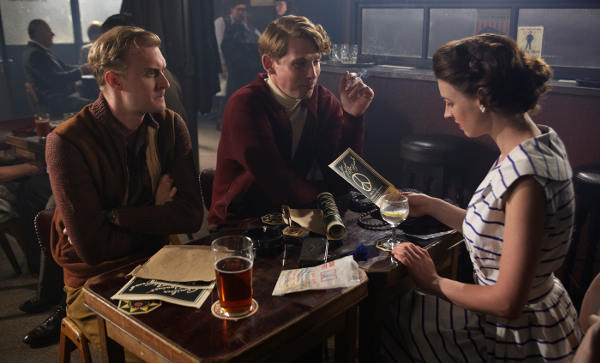For the third season in-a-row, we are honored to have the faculty of the Vanderbilt School of Nursing back to guest blog for us each Monday morning about the previous night’s episode of Call the Midwife, airing on Sundays on NPT and PBS Stations nationwide at 7:00 p.m. Central, March 30-May 18. Check in here every Monday morning for the next eight weeks for historical and contemporary context on the show, and some fun discussion. Plus, this year we’ll have the occasional bonus blog from across the pond to get the British perspective. So be sure to check the blog TWICE on Mondays. SPOILER ALERT: Some posts may contain spoilers, so please be aware of that.
By Margaret Buxton MSN CNM
 Are we all happy for a new season of Call the Midwife? Yes, we are. I foolishly set out to watch every episode without crying. Mission not accomplished (again). The juxtaposition of the two mother’s stories was fascinating. Nellie (Faye Daveney) is a young, motherless, and hopeful girl looking at her birth experience through the lens of her loss – feeling terrified to do it without her mother. The other is Doris (Seline Hizli), a mature mother of three boys with an unintended pregnancy of a biracial child, conceived in adultery. Both come to their birth events with longing and both were met with the best that midwifery has to bring: presence. Neither birth proved to be easy for anyone involved. Nurse Lee (Jessica Raine) had the difficult task of taking the sweet daughter out of Doris’ arms to foster care, understanding the pain but in the same moment protecting this mother and baby’s safety (amidst real threats from the husband). She did the job of looking after the baby, but she stayed with Doris. She checked on her health, but she cared more for her emotions – helping her get out of the house and encouraging normal routines.
Are we all happy for a new season of Call the Midwife? Yes, we are. I foolishly set out to watch every episode without crying. Mission not accomplished (again). The juxtaposition of the two mother’s stories was fascinating. Nellie (Faye Daveney) is a young, motherless, and hopeful girl looking at her birth experience through the lens of her loss – feeling terrified to do it without her mother. The other is Doris (Seline Hizli), a mature mother of three boys with an unintended pregnancy of a biracial child, conceived in adultery. Both come to their birth events with longing and both were met with the best that midwifery has to bring: presence. Neither birth proved to be easy for anyone involved. Nurse Lee (Jessica Raine) had the difficult task of taking the sweet daughter out of Doris’ arms to foster care, understanding the pain but in the same moment protecting this mother and baby’s safety (amidst real threats from the husband). She did the job of looking after the baby, but she stayed with Doris. She checked on her health, but she cared more for her emotions – helping her get out of the house and encouraging normal routines.
Nurse Miller (Bryony Hannah), excited by the innovative work of Grantly Dick-Read, helped young Nellie in what is probably the hardest way to give birth the first time: sunny-side up. You hear the midwife turn to her elder colleague and say, “She’s only 2 centimeters and she is OP.” Occiput Posterior (OP) means that the baby comes out “looking up” at the ceiling (most baby’s make their way out looking at the sheets with their faces down. Why does this matter? The baby’s bony skull is crashing against the bony part of Mom’s pelvis, the sacrum. This is very painful, slows labors down, and often leaves Mom with the urge to push long before her cervix is open. A long labor, increased back pain, and difficulty pushing the baby out is just the type of scenario that Grantly Dick-Read’s groundbreaking work was created for. He was moved by the women he saw giving birth consciously (remember wealthy women were “knocked out” with drugs like chloroform). He came to believe that fear and tension were the cause of agony in birth, and his book Childbirth Without Fear became the basis for the natural childbirth movement . Nellie’s tension and fear were made worse with not having the comfort of her mother there, but Nurse Miller understood that, helped her find her center, and celebrated a beautiful finale of a healthy baby boy.
I was very curious about the inclusion of the work of Dick-Read in this show. As we watch week to week, we take it as a given that all of these mothers are setting out to have natural childbirth. That was not the case. The truth is that they were too poor to afford to go to the hospital where drugs were offered to women of means. What the mothers of the East End did have were midwives who believed in them, and that is the most powerful labor drug of all.
Margaret Buxton, MSN CNM, is a Certified Nurse-Midwife, Instructor of Nursing, Vanderbilt School of Nursing and Clinical Practice Director, West End Women’s Health Center.
Read our Bonus British Perspective of this episode by Rachel Sykes here.
Missed our analysis of the Previous Season’s Episodes? Read them here.

1 Comment
This was perhaps my favorite episode of “Midwife” yet. This series does such a nice job presenting midwives in the light of their profession: women who offer care and compassion to other women. However, this show does more; it demonstrates the love and care that midwives have toward their patients that is often sadly lacking in today’s maternity care. It is a heartwarming display of midwives, “with women for a lifetime.”